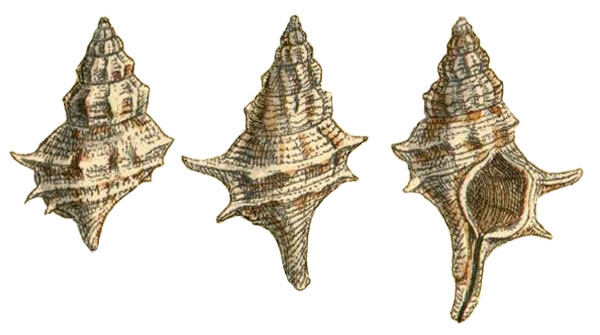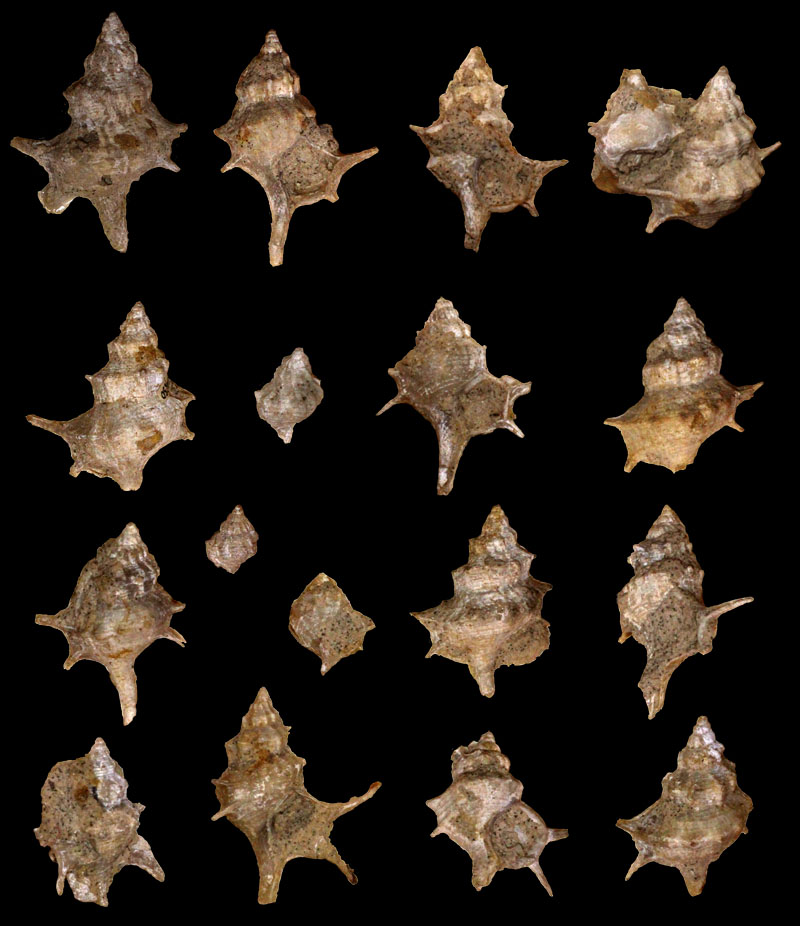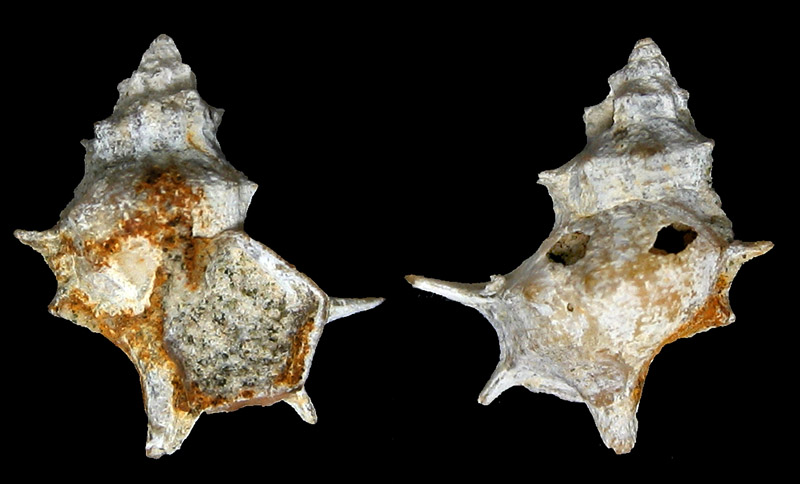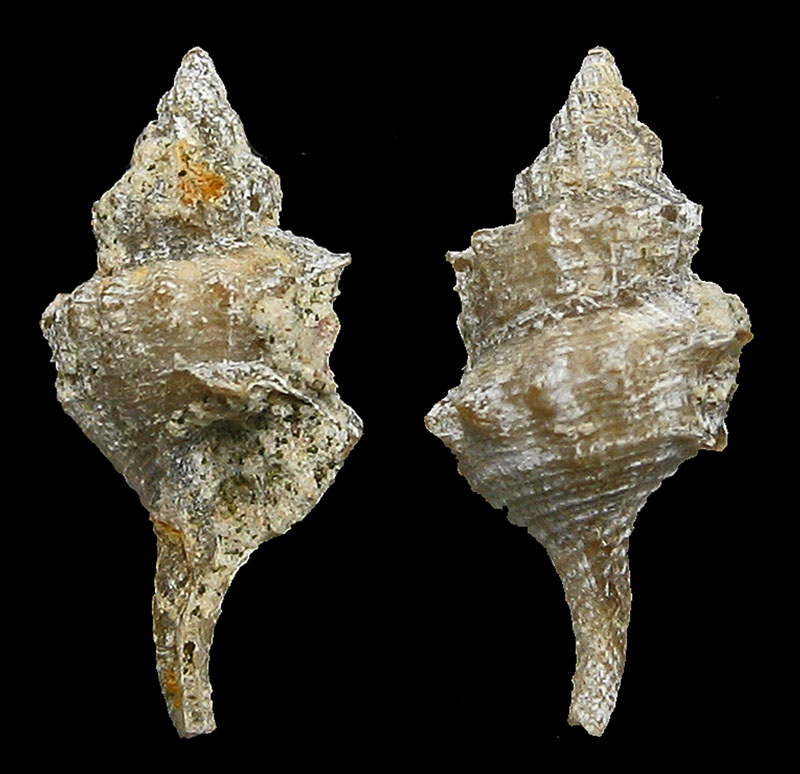- Murex calcar Sowerby, 1825
might belong to Cretaceomurex
Original Description of Murex Calcar by Sowerby, 1825, p. 7:
- "Ovato-acuminated, transversely striated, costated; last whorl bicarinated; each suture supports two or three long, sharp spines; aperture round, with a long canal."
- "The striae upon the surface of this Shell are few, elevated and partially granulated; the costae upon the spire are numerous and sharp; on the last whorl they are lost or at least only appear in the form of tubercles upon the uppermost carina; the sutures are few, and hardly distinguishable, except by the spines they are furnished with; these spines are only two in number, except in some few specimens which have a third obscure carina, and such have three spines; the aperture is nearly round with a small angle at its upper part; the left lip is raised from the columella; the canal of the beak is almost covered over. Smith in his "Strata identified by organic Fossils" has figured this upon the Green Sand plate without a name; the name above given, was found attached to some specimens in a dealer's hands, but we know not upon what authority.
Locus typicus: Blackdown Hills, Somerset-Devon Counties, South West Region, England
Stratum typicum: Green Sand of Blackdown, Albian, lower Cretaceous
Murex calcar Sowerby, 1825, pl. 410, fig. 2
Comment: this might belong to Spinilomatidae: Diempterus
History and Synonymy
Junior homonyms:
- Murex calcar Scacchi, 1835 (TROPHON calcar Scacchi, 1835, Ann. Civ. Reg. Due Sicilie, v. 7, p. 7, pi. 1, fig. 16)
- Murex calcar Kiener, 1842
1850
placed in Fusus by d'Orbigny, 1850, p. 155
1971
placed in "?Trophon" (Muricidae) by E.H. Vokes, 1971, p. 27
1983
Comment of Taylor, Cleeveley & Morris, 1983, p. 524, about Murex calcar:
- "We are uncertain of the systematic position of another of the more common gastropods, ´Murex´ calcar. Although it possesses some morphlogical features in common with the Miocene to Recent genus Murex sensu stricto, we believe that these result from convergence. For the present paper, our conclusion is to consider ´M´. calcar as belonging to an undescribed genus of the Mesogastropoda, that is perhaps related to the Strombacea."
1996
Woods & Jones, 1996, p. 38:
- "Blackdown Greensand Horizon B"
- "The sedimentological evidence suggests that the Blackdown Greensand represents part of a shallow-marine sand-bar complex, that was influenced by weak tides and rare storms. The occurrence of diverse, robustly ornamented trigoniids and gastropods preserving delicate spinose projections (e.g. 'Murex' calcar) is consistent with a fluctuating hydrodynamic regime."
Specimens from institutional collections
Murex calcar J. de C. Sowerby, Topotypes; Blackdown Greensand; Blackdown; Great Britain; Coll. Sedgwick Museum of Earth Sciences, University of Cambridge B44846-62
- ©2022. Sedgwick Museum of Earth Sciences, University of Cambridge. Reproduced with permission. This work is licensed under a Creative Commons Attribution-NonCommercial-ShareAlike 3.0 Unported License
Specimens from private collections
Cretaceomurex calcar (Sowerby, 1825); Blackdown Greensand Formation, upper Albian, lower Cretaceous; Blackdown Hills, Somerset-Devon Counties, South West Region, England; 19,6 mm; Coll. Daniel Ledon
Cretaceomurex calcar (Sowerby, 1825); Blackdown Greensand Formation, upper Albian, lower Cretaceous; Blackdown Hills, Somerset-Devon Counties, South West Region, England; 21,2 mm; Coll. Daniel Ledon
References
- Sowerby, James et Sowerby, James de Carle (1825) Mineral conchology of Great Britain (vol 5).
- J.D. Taylor, R.J. Cleevely & N.J. Morris, 1983. Predatory Gastropods and their Activities in the Blackdown Greensand (Albian) of England; Palaeontology 26(3), 1983, pp. 521-553
- Vokes, E.H. 1971. Catalogue of the genus Murex Linné (Mollusca: Gastropoda); Muricinae, Ocenebrinae. Bulletins of American Paleontology 61(268): 1-141.
- Woods, M. A. and Jones, N. S. 1996. The sedimentology and biostratigraphy of a temporary exposure of Blackdown Greensand (Lower Cretaceous, Upper Albian) at Blackborough, Devon. Proceedings of the Ussher Society, 9, 037-040.
Internet
- Museum of New Zealand 1, 2
- WoRMS: Murex calcar Kiener, 1842 (unaccepted, invalid: junior homonym of Murex calcar J. de C. Sowerby, 1823, and M. calcar Scacchi, 1835; M. tenuivaricosus and Chicoreus carioca are replacement names)




